Report on the Economic Well-Being of U.S. Households in 2015
- Preface
- Executive Summary
- Introduction
- Overall Economic Well-Being
- Income and Savings
- Economic Preparedness and Emergency Savings
Retirement
The survey also considers the extent to which respondents are preparing for the longer-term financial needs that they will face in retirement. To assess respondents' preparedness for their retirement years, the survey asks questions that probe their retirement plans, their retirement savings, and their expected path toward retirement. In general, the results demonstrate that many individuals, and especially those with lower incomes, are struggling to save for retirement. Additionally, even among those who are saving for retirement, a slight majority of respondents indicate that they have no or limited confidence in their ability to manage their self-directed retirement investments.
Saving for Retirement
Many respondents report that they lack retirement savings. When asked what types of retirement savings or pension they have, 31 percent of non-retired adults report that they have no retirement savings or pension whatsoever. This is unchanged from the percent of respondents in 2014 who reported no retirement savings.
The patterns of retirement savings differ substantially--and not surprisingly--by age. The percentage of people indicating that they lack retirement savings decreases with age. Nearly half of those ages 18 to 29 report that they have no retirement savings or pension, whereas approximately three-quarters of non-retirees age 45 or older have at least some savings. However, whether respondents have retirement savings as they approach retirement is highly dependent on their employment status (figure 34). While almost 90 percent of employed respondents age 45 or older have retirement savings, less than a third of those who are out of work due to a disability do. Since 13 percent of non-retired respondents ages 45 to 59 and 20 percent of non-retired respondents age 60 or older report that they are out of work due to a disability, these individuals constitute a sizeable fraction of the respondents who lack savings as they approach retirement age.
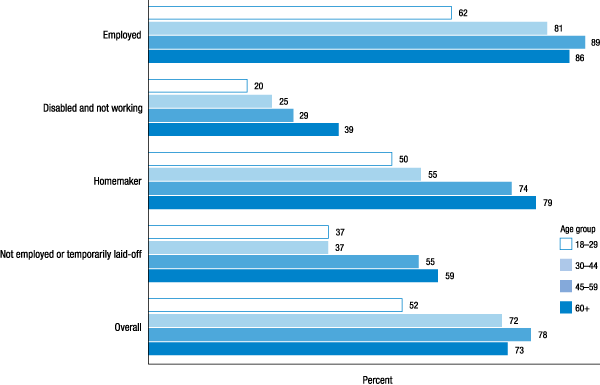
The lack of retirement savings is particularly acute for respondents with limited incomes and for racial and ethnic minorities. Sixty percent of non-Hispanic black respondents and 57 percent of Hispanic respondents have at least some retirement savings, compared to 74 percent of non-Hispanic white respondents (figure 35). Looking at retirement savings by income, 94 percent of respondents with a family income over $100,000 report that they have at least some retirement savings, and 82 percent of those making between $40,000 and $100,000 per year have some retirement savings. Among respondents making under $40,000 per year, 44 percent have any retirement savings.
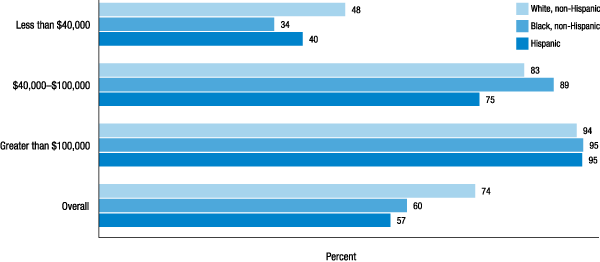
Since saving for retirement varies by employment status, individuals in lower-income families are less likely to have savings in part because they are less likely to be working. However, non-self-employed full-time workers in lower-income families are still much less likely to have savings (60 percent) than non-self-employed full-time workers in families with an income between $40,000 and $100,000 (90 percent) or over $100,000 (98 percent). This suggests that a portion of the gap is also due to either differences in retirement benefits for the types of jobs held by individuals lower in the income distribution, or the fact that even these lower-income individuals who work full time lack the financial capacity or wherewithal to save and contribute to retirement accounts.
In addition to collecting information on whether respondents have any retirement savings, those who do have savings are asked to indicate all the ways they are saving for retirement. The most commonly reported form of retirement savings is a defined contribution plan, such as a 401(k) or 403(b) plan, which 48 percent of non-retirees possess. This is nearly twice the 25 percent of non-retirees who participate in a traditional defined benefit pension plan through an employer. Twenty-seven percent of respondents report that they have an individual retirement account (IRA), and 41 percent indicate that they have savings outside of a formal retirement account. Additionally, 15 percent of respondents report having real estate or land that they plan to sell or rent to generate income during retirement, and 6 percent report having retirement savings through the ownership of a business. Each of these findings are largely consistent with those observed in 2014.
The survey also looks at whether respondents have borrowed or cashed out their retirement savings, and observes that at least some non-retired respondents who have, or had, retirement savings do not necessarily consider these savings to be sacrosanct. Four percent of those with retirement savings report that they borrowed money from a retirement account during the year before the survey. Moreover, 4 percent of those with such accounts report that they cashed out (permanently withdrew) some or all of their retirement savings in the prior 12 months, and 1 percent indicate that they both borrowed money from and cashed out retirement accounts in that time. Additionally, 5 percent of non-retirees without retirement savings say that they borrowed from and/or cashed out their retirement savings, reflecting that some individuals previously had savings but have depleted the funds in those accounts.47
Self-Directed Retirement Savings
As self-directed retirement savings are increasingly the expected approach to prepare for retirement, the survey seeks to better understand why some individuals are not saving for their retirement by asking employed respondents who do not participate in a 401(k) (or similar) plan a series of questions designed to capture why they do not participate.48 Among respondents who are employed for somebody else (thereby excluding those who are self-employed or contractors, along with those who are not working), 36 percent of respondents do not have a 401(k), or similar, account.49 Of those who work for somebody else and do not invest in such a plan, 53 percent report that their employer does not offer a plan, 5 percent report that their employer offers a plan for which they are not eligible, and 19 percent do not know if a plan is offered or not.
As observed previously for the likelihood of having any retirement savings, the likelihood of investing in a defined contribution plan through work is closely tied to one's income--even among those who are employed. Restricting the sample to non-students and non-retirees who are employed for someone else, 37 percent of respondents with a family income under $40,000 have a 401(k) account, well below the 69 percent of middle-income workers and 87 percent of high-income workers who have a 401(k) account.
This gap in the probability of participating in a defined contribution plan can be partially attributed to employers of lower-income workers not offering plans. Thirty-two percent of respondents who are employed for someone else and whose income is below $40,000 report that their employer does not offer a plan. However, not all workers that are not eligible for a plan would invest were their employer to provide one. Workers whose employer does not offer a plan, or who do not know if their employer offers a plan, are asked how likely it is that they would contribute to a 401(k) plan if it were offered. Among these workers, 59 percent say that they probably or definitely would contribute to a plan were it an option for them, but 26 percent say that they don't know and 16 percent indicate that they probably or definitely would not contribute. Among lower-income workers whose employer does not offer a plan, 53 percent say that they would probably or definitely contribute to a defined contribution benefit plan if it were offered.
The overall demand for a 401(k) account can be observed as those respondents who either have a 401(k) type account or who report that they would participate in their employer's 401(k) plan if it were offered. When combining the 37 percent of lower-income respondents who have a 401(k) type account with the 25 percent who would likely invest in one if offered, 62 percent of employed lower-income respondents express a demand for a 401(k) type retirement account (table 33). This compares to over 80 percent of respondents with a family income between $40,000 and $100,000 and over 90 percent of those in the highest income group who express a demand for a 401(k) type account in one of these ways. This suggests that while a portion of the difference in propensities to save in a 401(k) by income results from employer offerings, the lack of capacity or desire for lower-income individuals to save for retirement in this way also plays a substantial role.
| Category | Less than $40,000 | $40,000- $100,000 |
Greater than $100,000 |
|---|---|---|---|
| Has a 401(k), or similar, account | 37.3 | 68.8 | 86.8 |
| Employer does not offer a plan (or don't know); would participate if offered | 24.7 | 14.0 | 6.1 |
| Employer does not offer a plan (or don't know); would not or don't know if would participate if offered | 21.9 | 7.3 | 2.6 |
| Employer offers a plan; does not participate 1 | 16.1 | 9.9 | 4.6 |
Note: Among respondents employed for somebody else.
1. Respondents who are offered a plan but do not participate includes the respondents whose employer offers a plan but report that they are not eligible. These respondents are not asked if they would participate in the plan if they were eligible. Approximately 3.8 percent of employed respondents in the lowest income category, 1.2 percent in the middle income category, and 0.7 percent in the highest income category indicated that this is why they do not invest in a 401(k). Return to table
In addition to asking respondents whose employer does not offer a plan if they would contribute to a plan if it were offered, the survey asks respondents whose employer offers a plan, but who do not participate, why they do not invest through the plan. The most common reason, stated by 27 percent of these respondents, is an inability to afford contributions to the plan (figure 36). This was followed by those who prefer to save for retirement in other ways (20 percent), those who are unsure of the best way to invest contributions (18 percent), those who are not eligible for their employer's plan (18 percent), and those who plan to invest but have not yet signed up (16 percent). Smaller fractions reported that they simply prefer to spend the money rather than save, that their employer does not match contributions, or that they do not invest for other reasons.
Here there are noteworthy differences between men and women when it comes to reasons for not investing through their employer's retirement plan. In particular, women are more likely to cite being unable to afford contributions or being ineligible for their employer's plan. Among women who indicate that their employer offers a plan but that they do not participate, 31 percent report that they are unable to afford contributions to the plan, and 26 percent say they are not eligible to participate in the plan. This compares to 22 percent and 9 percent among men who do not participate in their employer's plan citing these reasons, respectively.
Figure 36. Reasons for not investing in employer's 401(k), 403(b), thrift, or other defined benefit contribution plan
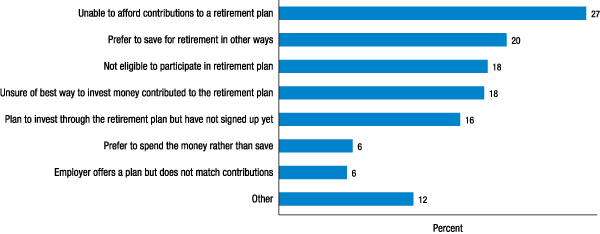
Note: Among respondents not currently retired who work for somebody else and do not invest in their employer's 401(k) type plan.
Looking at those respondents who do have self-directed retirement savings (including 401(k), IRA, and savings outside retirement accounts), the survey also observes that these investors are divided on whether they feel confident about their ability to manage these investments. Forty-nine percent of respondents with self-directed retirement accounts are either "not confident" or only "slightly confident" in their ability to make the right investment decisions when investing money in these accounts (figure 37). The remaining 51 percent are either "very confident" or "mostly confident" in their investment abilities. In general, men express somewhat greater levels of confidence in their investment capabilities, with 58 percent of men compared to 45 percent of women reporting that they are mostly or very confident that they will make the right investment choices.
Figure 37. How confident are you in your ability to make the right investment decisions when managing and investing the money in your retirement accounts?
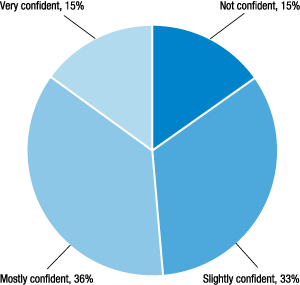
Note: Among respondents with retirement savings in a self-directed retirement account.
Given that many investors lack confidence in their ability to manage their investments, the survey seeks to understand where individuals obtain investment advice when making decisions on how to invest money in their retirement accounts. Forty percent of respondents who have self-directed retirement savings indicate that they receive professional financial advice, either from a financial planner, a lawyer, or an investment broker. Twenty-eight percent use financial advice received from friends or family; 24 percent use advice obtained from the Internet, books, or magazines; and 11 percent use advice received from their employer. Just over one-quarter of respondents, however, indicate that do not use any financial advice when deciding how to manage their investments.
There are several reasons why individuals may not seek out any financial advice, however. Among those who do not use any financial advice, 47 percent indicate that this is because they do not feel that they need help with their investments. But just over half report that they either cannot afford financial assistance (27 percent) or that they would like help but do not know where to go to get it (25 percent).
As was observed for the level of investment confidence, there is a gender gap in the likelihood that individuals feel that they need help but cannot afford it or do not know where to get it. Just over one-quarter of both men and women report that they use no advice from others when managing their investments. However, while 55 percent of men who do not use any advice say that they do so because they do not feel that they need it, only 39 percent of women that do not use any advice from others feel this way.
Expectations for Retirement
In addition to asking respondents about the retirement savings that they currently hold, the survey asks respondents about the sources of income that they plan to use to pay for expenses in retirement. There are differences by age in the sources of funds that respondents expect to use to pay for retirement expenses (table 34). This is especially apparent with respect to Social Security. Forty-two percent of those under age 30 say that they anticipate that Social Security benefits will be part of their plan to pay for expenses in retirement. This percentage steadily increases by age cohort, with up to 91 percent of those age 60 or older expecting to receive Social Security income in retirement.
| Source of funds | 18-29 | 30-44 | 45-59 | 60+ | Overall |
|---|---|---|---|---|---|
| Social Security | 42.3 | 58.9 | 80.9 | 90.7 | 65.3 |
| I will continue working | 40.3 | 41.1 | 34.2 | 37.6 | 38.3 |
| Spouse/partner will continue working | 22.2 | 24.4 | 19.5 | 18.9 | 21.6 |
| Defined benefit pension from work | 23.0 | 31.1 | 41.2 | 35.7 | 32.7 |
| 401(k), 403(b), thrift, or other defined contribution pension plan from work | 44.7 | 57.0 | 60.3 | 41.1 | 52.8 |
| Individual retirement account (IRA) | 25.9 | 31.3 | 35.5 | 34.3 | 31.6 |
| Savings outside a retirement account | 44.7 | 44.1 | 44.8 | 42.9 | 44.3 |
| Income from real estate or the sale of real estate | 15.0 | 17.8 | 20.4 | 18.8 | 18.0 |
| Income from a business or the sale of a business | 7.1 | 6.2 | 4.8 | 7.1 | 6.1 |
| Rely on children, grandchildren, or other family | 4.8 | 4.4 | 3.3 | 4.1 | 4.1 |
| Rely on inheritance | 7.3 | 8.0 | 7.5 | 4.3 | 7.2 |
| Other retirement savings | 13.7 | 11.6 | 14.8 | 16.9 | 13.8 |
Note: Among respondents who are not currently retired.
It is unclear whether these differences simply highlight the fact that older adults are likely to be thinking more actively about Social Security or if they represent diminishing levels of confidence among younger people about the future availability of Social Security benefits. Similarly, traditional defined benefit pension plans are less common as an expected source of retirement funding among younger respondents. Thirty-six percent of those age 60 and older are counting on income from a defined benefit pension, while 23 percent of those ages 18 to 29 plan on receiving income from a defined benefit pension.
Just over half of respondents expect to draw on a 401(k) account in retirement, 44 percent of respondents plan to rely on savings they hold outside formal retirement accounts to cover their expenses, and 32 percent plan to use savings in an IRA. Eighteen percent expect to sell or rent land or real estate to pay for retirement expenses. However, many non-retirees also expect continued employment to be a significant source of retirement income, with 38 percent of all respondents expecting to continue working in some capacity to cover their expenses and 22 percent expecting their spouse or partner to continue working.
Closely related to whether respondents expect to continue working into retirement, non-retirees are asked for the age at which they expect to retire fully and completely stop working for pay. Forty-four percent of respondents report that they do not know. Among respondents who provided an expected retirement age or indicated that they do not expect to ever retire, just under one-quarter expect to retire by age 62 and just under one-half expect to retire by age 65. However, 42 percent expect to either retire at age 70 or older or expect to never retire.
Experiences in Retirement
The survey asks respondents who are currently retired about their experiences in retirement and about how they manage their expenses. The most common age to retire is 62, with 16 percent of retirees who recall their retirement age stopping work at that age, followed by age 65, when 12 percent stopped working. Seventy-nine percent of these current retirees report that they had stopped working by age 65. This contrasts with that seen above among non-retirees, where only 48 percent of those who plan to retire and provided an expected retirement age expect to retire by age 65.50
When it comes to sources of funds in retirement, 90 percent of those in retirement are drawing Social Security benefits (figure 38). Sixty-five percent are drawing a traditional defined benefit pension, 53 percent draw on savings outside a retirement account, 43 percent use savings from an IRA, and 36 percent draw on a defined contribution plan. These results are comparable to those observed in the 2014 survey. When compared to the expected sources of income in retirement for non-retirees, individuals in retirement are more likely to report having income from a traditional defined benefit pension, even when compared to older working-age adults, and are less likely to report having income from a defined contribution pension plan.
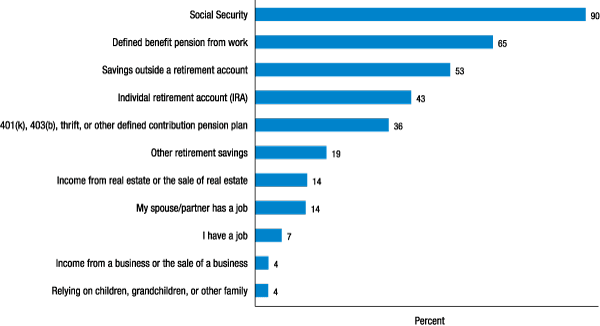
References
47. Some of these non-retired respondents may be cashing out from their retirement account to pay for retirement expenses as they near retirement. However, only 26 percent of respondents who cashed out a retirement account, 11 percent of those who borrowed money, and 10 percent of those who both borrowed and cashed out are age 60 or older, suggesting that may are doing so for other purposes. Return to text
48. Respondents are specifically asked about their participation in, and access to, a 401(k), 403(b), thrift, or other defined contribution plan from work. References in this section to 401(k) plans include both 401(k) plans as well as these other forms of defined contribution retirement accounts. Return to text
49. Students who also have a job are excluded in this section from those who are employed for somebody else, as they are not asked about the nature of their employment. Return to text
50. Results for expected retirement age are similar if restricting non-retirees to those under age 60, indicating that the results are not driven by the selection into retirement among older adults. Return to text
